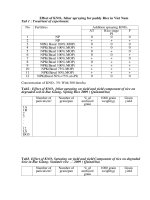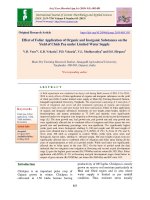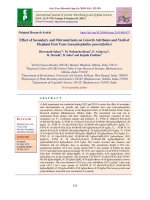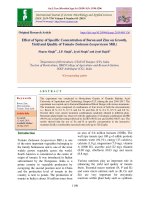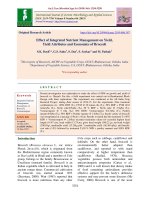Effect of sulphur and zinc on yield attributes, yield and economics of rice
Bạn đang xem bản rút gọn của tài liệu. Xem và tải ngay bản đầy đủ của tài liệu tại đây (196.07 KB, 7 trang )
Int.J.Curr.Microbiol.App.Sci (2018) 7(3): 531-537
International Journal of Current Microbiology and Applied Sciences
ISSN: 2319-7706 Volume 7 Number 03 (2018)
Journal homepage:
Original Research Article
/>
Effect of Sulphur and Zinc on Yield Attributes,
Yield and Economics of Rice
Waikhom Jiten Singh1*, Mahua Banerjee1 and L. Nabachandra Singh2
1
Department of Agronomy, Institute of Agriculture, Visva-Bharati, Sriniketan,
WB-731236, India
2
Department of Agronomy, College of Agriculture, Central Agricultural University Iroisemba,
Imphal West, Manipur-795004, India
*Corresponding author
ABSTRACT
Keywords
Kharif, rice,
sulphur, zinc, yield
attributes, yield and
economics
Article Info
Accepted:
xx February 2018
Available Online:
xx March 2018
A field experiment was conducted during kharif seasons of 2012 and 2013 at KVK
Thoubal, Manipur to assess the effect of different levels of sulphur and zinc on yield of
kharif rice (Oryza sativa L).The treatments consisted of four levels of suphur (0, 15, 20
and 25 kg/ha) and four levels of zinc (0, 5, 10 and 15 kg Zn/ha) laid out in factorial
randomise block design and which were replicated thrice. Application of 20 kg S/ha
recorded highest number of effective tillers/m2 (233.99), filled grains/panicle (100.95),
grain yield (56.3 q/ha), straw yield (64.8 q/ha) and harvest index (46.27%) over the
remaining treatment. Regarding test weight also 20 kg S /ha recorded the highest value and
least with control (0 kg S/ha). Application of 15 kg Zn/ha recorded highest number of
effective tillers/m2 (237.34), number of filled grains/panicle (99.21), test weight (23.63g),
grain yield (55.90 q/ha), straw yield (64.70 q/ha) and harvest index (40.06%), but it was
statistically at par with the 10 kg Zn/ha. Significant interaction effect of sulphur and zinc
on number of tillers per m2 of rice was observed in both the years and at pooled with the
highest value was observed at S20Zn15 (265.70) but remained at par with S15Zn15.
Significant interaction effect of sulphur and zinc on rice was observed in both years and in
pooled mean with highest value of 67.6 q/ha and 71.70 q/ha in S 20Zn15 for grain yield and
straw yield respectively. But this treatment remains at par with S15Zn15 and S20Zn10 for
straw yield. Regarding harvest index also, S20Zn15 recorded significantly highest value
(48.53%). Regarding the net return highest value was observed at S 20 Zn15 (Rs 29278.38),
however highest B: C ratio was recorded with the treatment combination of S 20 and Zn5
(0.63).
Introduction
Rice (Oryza sativa) the staple food crop of
Asia is cultivated approximately in 110
countries of the world and produced 385
million MT. Out of this, 90 % is produced in
Asia. It is the major staple food of 70 % of
Indian population and ranks second after
wheat in the world. It is the staple food crop of
southern, eastern and north eastern part of the
country particularly in Manipur. In Manipur,
rice is major predominated crop occupying
531
Int.J.Curr.Microbiol.App.Sci (2018) 7(3): 531-537
about 80 % of the total cropped area of state.
With increasing population, the demand of
rice in India is increasing and is expected to
reach 140 million tons by 2025 against the
present production level of 100 million tons
(Pandey et al., 2008). Scope for horizontal
expansion of production is limited as the
cultivated area for the last two decades is
almost constant 140 2 m ha (Gill and Singh
2009). The only possible means to meet the
ever increasing demand of rice is vertical
expansion of production with balanced
fertilization.
Till today, the focus for production
enhancement was on balanced fertilization of
N, P and K but of late it has been realized that
many secondary and micronutrients can
further boost up the productivity substantially.
Among different secondary and micronutrients
sulphur and zinc are most important nutrient
for rice as deficiency of these two are more
common in India. Out of 142 million ha arable
land in India, at least 57 million ha that is
about 40 % of total, suffers from various
degrees of sulphur deficiency (Tripathi, 2003).
Sulphur is required for increasing productivity
of crops especially legume, oilseed in India
where more than 50 % of soil have been
reported to be deficient in sulphur (Tewatia et
al., 2006).
Next to Sulphur, zinc is also reported deficient
from many rice growing regions of the
country. In India, analysis of 2.52 lakhs
surface soil samples collected from different
parts of the country revealed the
predominance of zinc deficiency on divergent
soils. Of these 49, 12, 4, 3, 33 and 41 % soils
are tested to be deficient in available zinc,
iron, manganese, copper, boron and sulphur
respectively (Singh 2004 and Prasad 2006).
According to Singh (2011), zinc deficiency in
Indian soil is expected to increase from 42 %
in 1970 to 63 % by 2025 due to continuous
depletion of soil fertility. Almost 50 % of the
world soil used for cereal production is zinc
deficient (Gibbson 2006). Nene (1966), in
India, firstly reported zinc deficiency in low
land rice. Afterward it has been recognized as
a wide spread and important nutritional
problem throughout the rice growing world.
According to Brar and Sekon (1976) zinc
availability is reduced by flooding owing to
the precipitation of zinc as ZnS (under intense
reduce condition), ZnCO3 (partial pressure of
CO2 coupled with decomposition of O.M.) and
insoluble Zn (OH)2 (in alkaline pH).
According to Patrick et al., (1985) zinc is
main limited micronutrient of flooded rice.
About 80-90 % of soil applied zinc is
unavailable to plant due to its various harmful
reactions with various soil components like
organic matter, clay, sesquioxide etc. So
chelated form of zinc (Zn EDTA) may be an
alternative source of Zn in crop production
(Basal and Nayyar 1989; Karak et al., 2002).
In Manipur, proper investigation for
delineation of secondary and micronutrient
have not been taken up, but few experimental
findings reported that, some pocket of
Manipur is low to medium in availability of
sulphur and zinc. According to Singh et al.,
(2006), the available sulphur (0.15% CaCl2
extractable S) range from 10 to 70 mg/kg in
thirty seven surface (0-15cm) soil sample
collected from different locations of Manipur.
Again Sarkar et al., (2002) reported available
Fe, Mn was high, Cu and Zn were low
particularly in sub surface horizon. Earlier,
zinc deficiency was not a problem in Manipur,
but now time has come to consider Zn status
of the soil. According to Shukla et al., (2016),
out of 1860 soil sample collected from
Manipur, 18.3 % soil are deficient in zinc.
The responses to the application of these two
nutrients have been supported by many
finding. Shah and Datta (1991) reported that
application of zinc @ 10kg Zn/ha were
sufficient to correct Zn deficiency in rice,
532
Int.J.Curr.Microbiol.App.Sci (2018) 7(3): 531-537
although the highest grain yield was obtained
with 40kg Zn/ha. Modest sulphur response
was recorded with 25kgs S/ha application,
when 40kg Zn/ha was applied together with S.
In contrast, high sulphur level beyond 25kg
S/ha decreased grain yield when it was applied
with zinc. Positive response for application of
sulphur and zinc on rice crop had also been
reported by Ranjita (2010) on experiment
conducted at CAU Campus, Imphal, Manipur.
Materials and Methods
The study was conducted in kharif season for
the two consecutive years (2012 and 2013) at
the Krishi Vigyan Kendra, Thoubal, Manipur,
India located at 24060.84'817"N latitude and
94°00.28'757"E longitude. The soils of the
experimental plot had silty clay texture, pH
5.76, organic carbon 0.98 %. Weather
conditions like rainfall, maximum and
minimum temperature and relative humidity
during the crop growth period (June to
October) were 112.26 mm, 33.2oC, 16.8oC and
75.4 % during 2012 and 160.62 mm, 34.24oC,
21.6oC and 79.5 % during 2013, respectively.
Paddy seeds were grown in a nursery bed
following standard methods of nursery raising
and transplanted to main field at an age of 25
days. Flooding method of irrigation was
applied depending on rainfall pattern during
the crop period to maintain water requirement.
The treatment consisted of four levels of
suphur (0, 15, 20 and 25 kg/ha) and four levels
of zinc growth (0, 5, 10 and 15 kg Zn/ha) laid
out in FRBD and which were replicated thrice.
Sulphur and zinc were applied through
bentonite sulphur and zinc EDTA as per
treatment before transplanting. In all the
treatments, constant dose of 60:40:30 kg; N:
P: K /ha were applied. Half amount of N and
whole amount of P2O5 and K2O were given
before transplanting as basal and remaining
half were given in two equal doses at 30th
DAT and 60th DAT.
Results and Discussion
Number
of
tillers/m2,
number
of
grains/panicle, test weight, grain yield,
straw yield, harvest index and economics of
rice
Number of tillers/m2, number of grains/panicle
and test weight varied significantly among the
treatments. Number of tillers/m2 and number
of grains/panicle increased in the sulphur level
up to 20 kg S/ha (Table 1). Tillering is the
product of expanding auxiliary buds and is
closely associated with nutritional condition of
the mother culm during its early growth
period, which get improved by application of
sulphur as it improve use efficiency of other
nutrient particularly nitrogen and phosphorus
(Samaraweera 2009 and Asha Ram et. al.,
2014). On an average, the highest number of
tillers/m2 and number of grains/panicle at 20
kg S/ha was 17.75% and 8.58 % respectively
higher than the lowest in control. Reduction in
number of tillers/m2 and number of
grains/panicle was recorded at higher levels of
S (25 kg/ha) compared to 20 kg S/ha. Test
weight increased with increase in S level up to
20 kg S/ha and increase per cent was 4.02 %
higher than control. Likewise, on an average,
the highest grain yield, straw yield and harvest
index at 20 kg S/ha were 32.47 %, 20.00 %
and 5.57 % respectively higher than the lowest
in control. Higher grain and straw yield due to
S may be attributed to increase in growth and
yield character of rice and to the stimulating
effect of applied S in the synthesis of
chloroplast protein resulting in greater
photosynthetic efficiency, which increase the
yield. Our findings are supported by the
results of Chandel et. al., (2003), Qamar et.
al.,(2014) and Rahman 2009.
Numbers
of
tillers/m2,
number
of
grains/panicle and test weight were
significantly higher with 15 kg zinc ha-1 (Table
1) by
24.11 %, 8.21 % and 3.32 %
533
Int.J.Curr.Microbiol.App.Sci (2018) 7(3): 531-537
respectively over control, whereas it was
statistically at par with 10 kg zinc ha-1.
Adequate level of zinc in soil increase tillering
and consequently increased number of
panicle/m2 and again as zinc is responsible for
pollen formation and seed production, number
of grains/panicle is more in zinc applied plot
than control. These findings have similarity
with result of Meena and Shivay (2010) and
Jat et. al., 2011. Zinc as a synthesizer of
protein and carbohydrate resulted into bolder
seeds compared to control resulting into more
test weight. The results are in accordance with
finding of Balu et. al., (2014). Highest value
of grain yield and straw yield was recorded in
15 kg zinc ha-1 (Table 1) which was 39.05 %
and 25.15 % respectively higher than control.
Higher values of yield attributing characters
resulted in higher values of grain yield.
Maximum harvest index of 46.09 % was
registered with 15 kg Zn ha-1 and minimum
43.57 % was observed in 0 kg Zn ha-1.
Significant increase in harvest index suggested
that plant maintained a higher supply of
photosynthates to reproductive parts as
compare to vegetative biomass.
These findings have similarity with result of
Meena and Shivay (2010) and Jat et al.,
(2011). Zinc as a synthesizer of protein and
carbohydrate resulted into bolder seeds
compared to control resulting into more test
weight. The results are in accordance with
finding of Ram et al., (2014). Highest value of
grain yield and straw yield was recorded in 10
kg zinc ha-1 (Table 1) which was 23.88 % and
16.28 % respectively higher than control.
Higher values of yield attributing characters
resulted in higher values of grain yield.
Maximum harvest index of 46.08 % was
registered with 15 kg Zn ha-1 and minimum
44.37 % was observed in 0 kg Zn ha-1.
Significant increase in harvest index suggested
that plant maintained a higher supply of
photosynthates to reproductive parts as
compare to vegetative biomass.
Table.1 Effect of sulphur and zinc on number of effective tillers/m2, number of filled
grains/panicle and test weight, grain and straw yield and harvest index of rice (Pooled data of
2012-13 and 2013-14)
Treatment
S0
S15
S20
S25
SEm±
CD at 5%
Zn0
Zn5
Zn10
Zn15
SEm±
CD at 5%
Number of
tiller/ m2
198.72
223.69
233.99
211.67
3.86
11.15
191.23
213.17
226.32
237.34
3.86
11.15
Number of
grains/
panicle
92.97
96.16
100.95
94.43
1.07
3.09
91.68
95.51
98.11
99.21
1.07
3.09
Test
weight
(g)
22.88
23.42
23.80
23.17
0.13
0.37
22.87
23.25
23.53
23.63
0.13
0.37
534
Grain
Yield
(q ha-1)
42.5
50.50
56.30
46.40
0.90
2.60
40.20
47.40
52.20
55.90
0.90
2.60
Straw
yield
(q ha-1)
54.00
61.1
64.80
57.70
0.80
2.40
51.7
58.80
62.30
64.70
0.80
2.40
Harvest
index (%)
43.83
45.10
46.27
44.44
0.14
0.42
43.57
44.54
45.43
46.09
0.14
0.42
Int.J.Curr.Microbiol.App.Sci (2018) 7(3): 531-537
Table.2 Interaction effect of sulphur and zinc on number of tillers/hill, number of grains/panicle and test weight of rice
Number of tillers/ hill of rice.
Number of grains/ panicle of rice.
Treatments Zn0 Zn5 Zn10 Zn15 Mean
Zn0
Zn5
Zn10
Zn15 Mean
5.08 6.10 6.29 6.7 6.04
87.15 92.36 95.91 96.00 92.86
S0
S0
S0
6.08 6.65 7.12 6.94 6.70
S15
S15 91.51 95.30 99.92 103.77 97.62 S15
6.47 6.88 7.35 6.95 6.91
S20
S20 93.45 96.87 103.04 101.55 98.73 S20
6.72 7.22 7.73 5.81 6.87
S25
S25 96.20 99.11 104.92 92.81 98.26 S25
Mean
6.09 6.71 7.12 6.60
Mean 92.08 95.91 100.95 98.53
Mean
S*Zn
S*Zn
SEm±
SEm±
SEm±
0.37
3.00
CD at 5%
0.76
CD at
5%
6.13
Test weight of rice (g).
Zn0
Zn5 Zn10 Zn15
23.19 24.07 24.21 24.41
24.08 24.32 24.33 24.71
24.30 24.59 24.63 24.79
24.44 24.79 24.77 24.17
24.00 24.42 24.49 24.54
S*Zn
0.27
CD at
5%
Mean
23.97
24.36
24.56
24.54
0.55
Table.3 Interaction effect of sulphur and zinc on grain yield, straw yield and harvest index of rice
Grain yield of rice (q ha-1).
Treatments
Zn0
Zn5
Zn10
Zn15
Straw yield of rice (q ha-1).
Mean
Zn0
Zn5
Zn10
Zn15
Harvest index of rice (%).
Mean
Zn0
Zn5
Zn10
Zn15
Mean
S0
33.82 44.70 48.01 51.70 44.56
S0
44.70 55.95 59.36 62.30 55.58
S0
43.05 44.42 44.70 45.31 44.37
S15
44.12 50.69 57.05 58.52 52.60
S15
56.00 61.79 66.28 66.75 62.71
S15
44.06 45.06 46.26 46.70 45.55
S20
48.33 53.80 61.12 57.50 55.20
S20
59.69 64.14 68.42 66.28 64.63
S20
44.76 45.60 47.15 46.45 45.99
S25
51.89 58.42 66.14 42.88 54.83
S25
62.49 66.74 70.86 64.47 63.64
S25
45.36 46.65 48.28 44.01 46.08
Mean
44.55 51.90 58.08 52.65
Mean 55.72 62.15 66.23 62.45
S*Zn
SEm±
CD at 5%
Mean 44.31 45.43 46.62 45.62
S*Zn
3.93
SEm±
8.03
CD at
5%
535
S*Zn
2.27
SEm±
0.49
4.63
CD at
5%
1.00
Int.J.Curr.Microbiol.App.Sci (2018) 7(3): 531-537
Significantly highest tiller per plant, grains
per panicle, grain yield, straw yield and
harvest index was obtained with the treatment
combination S25Zn10 (Table 2 and 3) but
statistically on par with some other treatment
combinations including S20Zn10 and S25Z5.
But, for test weight S20Zn15 recorded highest
value. Antagonistic effect of interaction was
observed at highest levels of sulphur and zinc
i.e. S25Zn15. Similar observation was also
reported by Rasvel and Rivechandran (2013).
and micronutrient application. Indian
journal of fertilizer, 5(4): 59-66, 69-76,
79-80 & 106.
Jat, S. L., Shivay, Y. S. and Parihar, C.M.
2011. Dual purpose summer legumes
and zinc fertilization for improving
productivity and zinc utilization in
aromatic hybrid rice (Oryza sativa).
Indian journal of Agronomy, 56(4):
328-333.
Karak, O.T., Das, D.K. and Karmakar, S.K.
2002: In proc. 17th World congress of
Soil Science, held on 14-21 August
2002 at Bangkok Thailand Paper no. 64.
Meena, H.N. and Shivay, Y.S. 2010.
Productivity of short duration summer
forage crops and their effect on
succeeding aromatic rice in conjunction
with gypsum enrich urea. Indian
Journal of Agronomy, 55(1): 11-15.
Nene, Y.L. 1966. Symptom, Cause and
control of Khaira disease of paddy. Bull
India phytopathol Society, 3: 97-101.
Pandey, M.P., Rao, S. and Saha, S. 2008:
Agro economic analysis of rice base
cropping systems. Indian Journal of
fertilizer, 4 (4): 39–47.
Patrick WH Jr, D.S. Mikkelsen and Wells,
B.R. 1985: Plant nutrient behavior in
flooded soil P 197-228 In O.P.
Engelstad (ed). Fert technology and use
3rd ed. SSSA, Madison W.I.
Prasad, R. 2006. Zinc in soils and plant,
human and animal nutrition. Indian
Journal of fertilizers, 2(9) 103-19.
Qamar, S, Sajed, P., Qudratullah Shahab,
Dost Mohammad, Sazid Bashir, Nazeer
Ahmed, Saeed Ahmed Muhammad and
SahidUl Islam 2014: comparative effect
of soil and foliar application of sulphur
on Maize 10SR Journal of Agriculture
and Veterinary Science, vol 7 issue 4.
Rahman, M. S., Ahmed. M.V., Rhman, M.M.,
Islamand M.R. and Zafur, A. 2009:
Effect of different levels of sulphur on
the growth and yield of BRRI Dhan. 41:
Regarding the net return per rupees invested
highest value was observed at S20 and Zn5 (Rs
0.54 and Rs 0.46 respectively).
From the above finding, it can be concluded
that zinc and sulphur play a role in yield
attributes and yield of transplanted rice. Even
though the highest grain yield (66.14 q/ha)
was observed in treatment combination
S25Zn10 it is preferable to recommended lower
dose of zinc and sulphur i.e. S20Zn5 (57.05
q/ha) as higher dose zinc for soil application
is not cost effective.
References
Basal, R.L. and Nayyar, V.K. 1989: IRRI
News letter, 14: 24
Brar, M.S. and Sekhon, G.S. 1976: Effect of
Fe and Zn on the availability of micro
nutrients under flooded and unflooded
condition. Journal of India Society of
Soil Scienc, 24: 446-454
Chandel, R.S., Sudhakar, P.C and Singh, K.
2003: Response of Sulphur nutrition in
Mustard. A Review. Agric Review,
24(3): 175-182.
Gibbson. 2006. Zinc the missing link in
combating micro nutrient malnutrition
in developing country. Proceeding of
the nutrition society, University of East
Aglia Norwich June 28 July 1 2005.
Gill, M.S. and Singh, M.K. 2009. Productivity
enhance of cereal through secondary
536
Int.J.Curr.Microbiol.App.Sci (2018) 7(3): 531-537
Bangladesh
Research
publication
journal. 3(1): 846-852.
Ram, A., Kumar, D., Singh, N. and Anand, A.
2014: Effect of sulphur on growth,
productivity and economics of aerobic
rice (Oryza sativa). Indian Journal of
Agronomy, 59(3): 404-409.
Ram, B., Singh, S.K., Latare, A.M. and
Kumar, O. 2014: Effect of sulphur, zinc
and boron application on growth and
yield of hybrid rice (Oryza sativa).
Journal of Indian Society of Soil
Science, 62(2): 184-188
Ranjeta, K. 2010: Response of transplanted
rice to Zn and S with reference to
growth and yield. MSc Thesis
submitted to CAU Imphal. Manipur.
Rasvel, M. and Rivechandran, M. 2013:
Effect of Zn, P and S interaction on
growth and yield of rice under neutral
and alkali soil. International journal of
current research, 5(1): 65-67.
Samaraweera, D.N. 2009: Studies on form
and transformation of sulphur and
response of rice to sulphur application
in rice-rice cropping sequence. Ph.D
thesis submitted to University of
Agricultural Sciences, Dharwad.
Sarkar, D., Baruah, U., Gangopadhyay, S.k.,
Sahoo, A.K. and Velayutham, M. 2002:
characteristic and classification of soil
of Loktak land use planning. Journal of
Indian Society of soil Science. 50(2):
1996-204.
Shah, A.L. and Datta,S. K. De. 1991: Sulphur
and zinc interaction on low land rice.
Philippines journal of crop science.
26(1): 15-18.
Shukla, A.K., Tiwari, T.K., Pakhir, A. and
Prakash Ch. 2016: Zinc and Iron in soil,
plant, animal and human health. Indian
journal of fertilizers, 12(11): 133-149.
Singh, A. H., Singh, R.K. Kumarjit, Singh N.
G, Chongtham, N. and Singh A.K.K.
2006: status and forms of S in Acidic
soil of Manipur. Journal of Indian
Society of soil Science. 54(31): 351-353
Singh, M.V. 2004. Micro nutrient deficiency
in Indian soils and field useable
practices for their correction. IFA
conference on micro nutrient. Feb 23-24
2004 at New Delhi.
Singh, M.V. 2011. Scenario of Zn deficiency
in Indian soil and its influence on Zinc
enrichment in crop for improving
human and animal health. Presented at
3rd international Zn symposium.
Improving crop produce and human
health. Hyderabad India Oct. 10-142011.
Tewatia, R.K., Choudhari, R.S. and Kalwe,
S.P. 2006: TSI-FAI-IFA sulphur
project-salient findings. (In) Proceeding
of TSI-FAI-IFA Symposium cum
workshop on Sulphur in Balance
fertilization, held at New Delhi pp. 1525.
How to cite this article:
Waikhom Jiten Singh, Mahua Banerjee and Nabachandra Singh, L. 2018. Effect of Sulphur and
Zinc on Yield Attributes, Yield and Economics of Rice. Int.J.Curr.Microbiol.App.Sci. 7(03):
531-537. doi: />
537
